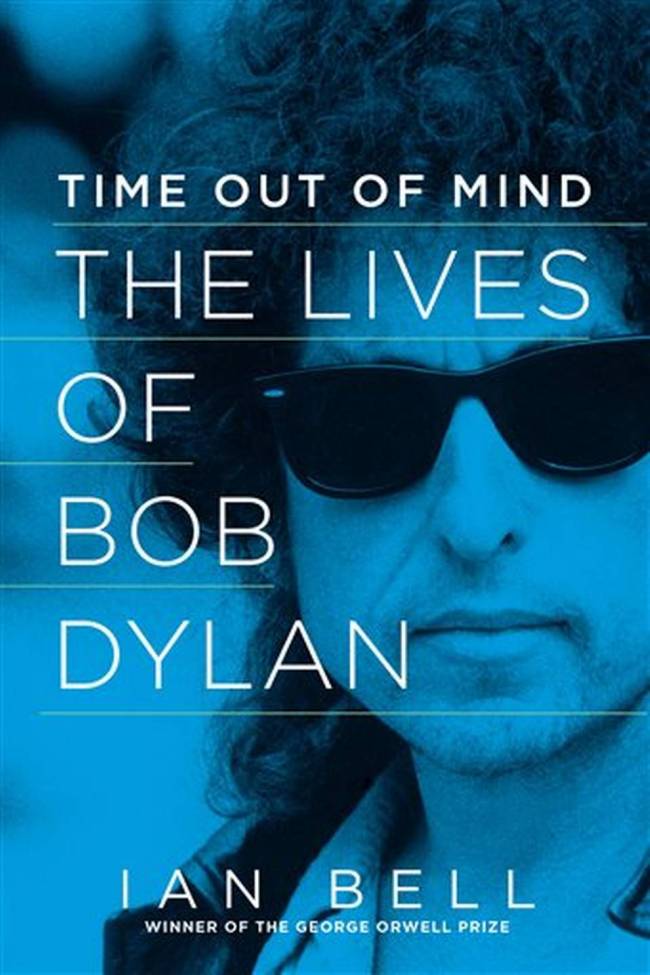The second installment of Ian Bell’s two-part biography of Bob Dylan, “Time Out of Mind,” is a compelling, focused examination of the latter half of the elusive singer-songwriter’s life and career, starting off with his acclaimed “Blood on the Tracks” album in 1975 and bringing readers close to the present day.
For Dylan’s many obsessive fans, who have been offered a wealth of analyses of this singular artist over the years, Bell delivers the goods. Chapters are heavy with engrossing and sometimes surprising details of Dylan’s most potent works and cringe-worthy missteps during this time, all told in the Scottish journalist’s sharp-sighted, biting style.
At its core, Bell’s ambitious work is more of an analysis of Dylan’s tangle of identities and creative visions than a standard biography of an arena-filling musician. He meticulously documents Dylan’s oeuvre since 1975, including a lengthy stretch of artistic decline spanning the 1980s when the singer-songwriter acclaimed as a dazzling, once-in-a-lifetime genius for much of his youth was mostly being written off as a contrary has-been by his 40s.
“Between the appearance of the hectoring evangelical Christian album ‘Saved’ in June of 1980 and 1997’s ‘Time out of Mind’ the test was to find a good word to say about Dylan’s works, then to find more than a handful of people likely to give a damn,” he writes in a typically tough-minded passage.
 |
Rock legend Bob Dylan looks on during the Presidential Medal of Freedom ceremony at the White House in Washington, D.C., on May 29, 2012. (Abaca Press/MCT) |

But since the release of the Grammy-winning album “Time Out of Mind,” Bell convincingly argues a resurgent Dylan has forged an unprecedented renaissance and “vindicated himself” after a lengthy slump. In Bell’s words: “He had defied age, time and, above all, every prowling, mocking ghost that had ever borne the name Bob Dylan.”
Since 1997, with potent albums like “Modern Times” in 2006 and “Tempest” in 2012, Bell claims that Dylan has created a body of work late in his life that could even match the dizzying achievements of the 1960s, his most revolutionary, incendiary stretch. Plus, Dylan pulled it off while contending with advancing age and a deteriorating voice that is a “magnificent ruin, a thing of wonder and dismay.”
To his credit, Bell is no hagiographer. Just as he did in his first Dylan volume, “Once Upon a Time,” he appears to take pleasure in tearing down myths that have attached themselves to the man over the years. Like others before him, Bell sometimes portrays the artist as a jerk. For instance, he asserts that “Sara,” an unprecedentedly personal song from the 1976 “Desire” album that Dylan unveiled for his first wife as their marriage was collapsing, could be described as a “piece of sentimentalized emotional blackmail” just as easily as a love song.
Bell is at his best when he makes his strong case that Dylan is a deeply spiritual writer whose songwriting was infused with religious imagery from the beginning for a reason. But the trilogy of albums that the singer-songwriter, raised Jewish in Hibbing, Minnesota, released between 1979 and 1981 when he embraced evangelical Christianity were far from a creative apex, according to Bell. In one of his better quips, he writes: “Christ didn’t make a Gerard Manley Hopkins of the artist when He interceded.”
Still, he treats Dylan’s lifelong spiritual quest with the respect it deserves, even if his most overtly religious work mystified those fans who believed him to be some kind of counterculture idol who only used biblical imagery as a lyrical tool. He writes: “What truly matters where religion and Bob Dylan are concerned is that the search for faith has endured through each and every one of his fragile, transitory identities. It might be the biggest fact of them all.”
The flattest sections of the book are when Bell takes to descriptions of America’s changing political and cultural eras between specifics of Dylan’s personal life and musical career. Pages touching on the administrations of U.S. presidents pop up a few times and the observations are mostly tedious. For instance, he briefly contends that in many ways “Ronald Reagan and Bob Dylan were not so very different.” Really?
But Bell’s “Time Out of Mind” is doggedly researched, full of insight and descriptions that wonderfully reveal aspects of this luminary of American music. At over 500 pages, however, it’s likely for Dylan devotees only.
By David McFadden
(Associated Press)









